15 Best Ground Cover Perennial Plants
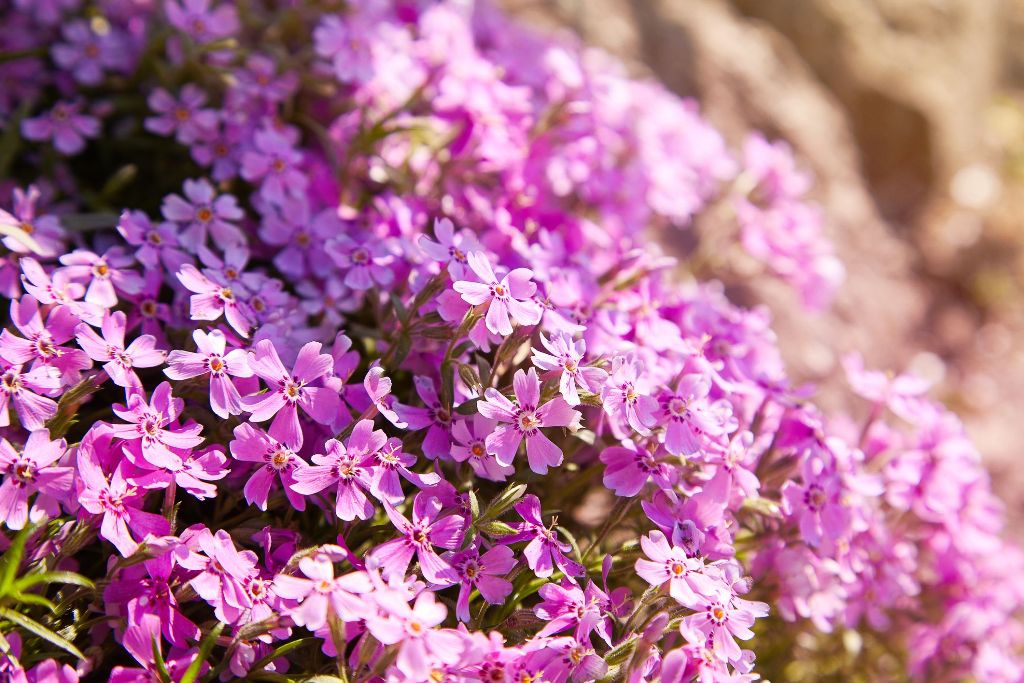
Perennials are plants that possess the ability to live for more than two years. These plants are mostly non-woody and blossom during springs and summers falling back to the ground, indicating their dormancy during fall and frost. The cycle of actively growing and flowering and dormancy occurs every year based on the individual longevity of the plants. Although some trees and shrubs live for a significant lifetime, flowering perennials mostly have a lifetime of a couple of years only due to which it is advisable to replace them once in two to three years. Similarly, while a few perennial shrubs and trees have the ability to flaunt their leaves all through the year, some flowering perennials stay through a constant state of dormancy all through the year, except a few weeks during which they bloom. The roots regain their activeness and come back to life, developing new plant tops.
Why Should Perennials Be Grown?
There are many reasons why perennials are the ideal choice for you to grow in your meadows, window boxes, hanging baskets, or as a bedding for your garden. A few are mentioned below to help you realize the merits of perennials.
1. Maintenance of Perennials
Perennials save immense amounts of your time and don’t crave much for your attention, energy, and water. It is ideal for planting them during fall or spring. You don’t have to be worried if your plant did not flower during the first year as during the first year, the plant devotes its attention only in strengthening and anchoring roots due to which flowering might be missed out during that period. Although perennials are low maintenance, perennials need to be periodically checked for weeds while they are growing, and once the plant reaches its maturity, they don’t demand your attention.
2. Investment
Perennials are pocket-friendly as they have greater longevity when compared to the annuals which live only for a year. Perennials multiply every year and also provide you with the added luxury of dividing them and planting them in various other landscapes of your choice by naturalizing.
3. Ornamental Value of Perennials
Perennials are what you need if you want your garden to beam with colors as they have high ornamental value brought by their vibrant flowers and green leaves.
Things To Consider Before Buying A Perennial Plant
Hardiness Zone
Being aware of the hardiness zone of the location in which you are planning to plant is paramount. Although some plants are capable of resisting frost, some plants can die even by the slightest cold breezes. USDA has announced 12 hardiness zones to make people aware of the temperature tolerance of plants.
Planting Season
Perennials need to be planted either during spring or during fall, as these seasons are the times when the plant is either entering the frost dormancy or coming out from the same. This time is highly ideal for the plants as new roots find it easier to strengthen and establish at milder temperatures because of the moisture in the ground.
Height
The perennials are capable of growing up to a maximum height of 60 inches even though most plants start outgrowing from the same height. Planning the exact location of the plant in your garden before planting can enable you to figure out the neighbors of the plant and enable you to grow the plant smoothly.
Sun and Shade
Almost all plants require a certain amount of light for thriving, and over or under exposure to sunlight might have varying impacts on the plant. Analyzing the light conditions that different regions of your garden receive are paramount to provide your plant with the best-growing conditions. Categorize your garden into full sun, shady, and part sun areas. Full sun areas obtain more than six hours of sunlight, part sun areas obtain between four to six hours of sunlight, and the shady regions obtain sunlight for lower than four hours.
Soil Requirements
Perennial plants thrive on fertile soils that are capable of good drainage. This is because good drainage is essential for the strengthening and anchoring of the root system. The moisture level in soil should also be good for the soil to support the plant. Always make sure to choose your perennials based on the location you plant.
Here is a list of 15 best groundcover perennial plants for your garden. Have a look:
1. Packy Half Flat Pachysandra Groundcover
This plant is everything your garden requires if you want to adorn your garden with upright and evergreen groundcover. Pachysandra grows in shady landscapes like tree bottoms and under trees and blooms white flowers in spring, brightening your garden with green and pleasant ambiance.
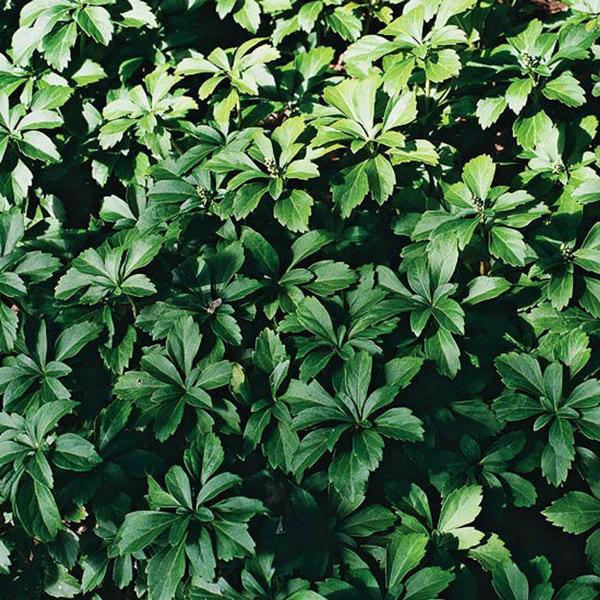
| PROS | CONS |
| Pachysandra adds an unmatchable dose of greenery to your garden. It is easily adaptable, as already mentioned above, it is greatly advantageous. It does not require frequent watering. | The bleached look of Pachysandra’s leaves, if exposed to sunlight, is one of the concerns expressed by growers. Pachysandra shows slow-paced growth. |
SPECIFICATIONS
- This perennial is shipped as a container.
- This perennial grows to a maximum height of 8 in. and a maximum width of 12 in.
- The ideal time for planting this perennial is from spring to fall.
- The color of the blooms is white.
- The botanical name of this perennial is Pachysandra.
- This perennial has no scent.
- This plant requires a minimum spacing of 12 inches between its plantings.
- This perennial can be returned within 180 days.
- This perennial is capable of tolerating part sun.
- This perennial attracts pollinators such as bees.
- Deer and Rabbits are deterred by this perennial.
- The growth habit of this perennial is mat-forming.
- The hardiness zone of this perennial is 5 (-20 to -10 F),9 (20 to 30 F).
- This perennial needs water only when the soil is dry.
KEY POINTS
- The readily adaptable nature of this plant to adapt to dry and shady areas makes this a more preferable choice for growers.
- Soil erosion is greatly controlled by this plant owing to the stems of this perennial, which spreads to form a mat-like structure.
FAQ
Q1. Is Pachysandra a good choice to grow in sunny areas?
The foliage of Pachysandra becomes pale and bleached on over-exposure to the sun, which is why it is not preferable to grow Pachysandra under the sun.
Q2. How frequent is watering required for Pachysandra?
Pachysandra needs water only when the soil is dry and out of moisture.
2. Super Blue Lily Turf (Liriope) Grass with Violet Purple Flower Spikes in Summer
Liriope is an ideal ground cover grass with tall and dark bluish-green foliage, which is enough to brighten your garden. This perennial gives blossoms during the summer of purplish violet coloration, contrasting the blues of the leaves. As the flowering season meets their end, the blossoms are replaced by brightly colored berries. The plant is found to give out a greeny glow during warmer climates. During colder climates, the plant turns brown but returns to life at the onset of spring. The growth of new leaves can be encouraged by mowing down dead, dry leaves just before spring arrives. It is greatly recommended to grow this plant in garden soils that can provide good drainage. Flowers can be expected towards the end of the summer. The plant is considerably disease-resistant and also does not demand much of your attention and water, which is why this plant can be the perfect ground cover for your garden, blessing it with immense greenery.
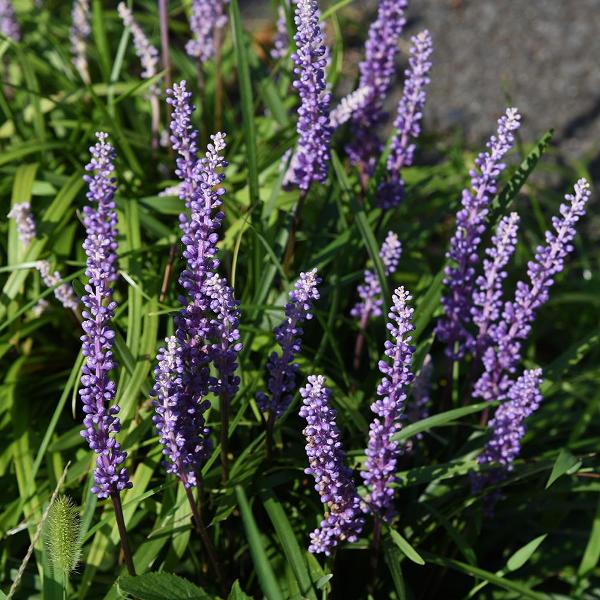
| PROS | CONS |
| This plant is low maintenance and grower-friendly plant. The look of your garden will surely be uplifted by planting this perennial as a ground cover. This perennial requires watering twice a week only. | Keen monitoring is required for checking weeds, and it is paramount to pull them off before their spreading. |
SPECIFICATIONS
- This perennial is shipped as a container.
- This perennial grows to a maximum height of 18 in. and a maximum width of 24 in.
- The best time for planting this perennial is from spring to fall.
- This perennial gives purple blossoms.
- The botanical name of this perennial is Muscari Super Blue.
- This perennial possesses no scent.
- This plant has to have a minimum spacing of 10 inches between its plantings.
- This perennial can be returned within 180 days.
- This perennial can tolerate part sun.
- This perennial attracts no wildlife.
- This perennial does not deter any wildlife.
- The growth habit of the perennial is clumping.
- The hardiness zone of this plant is 10 (30 to 40 F),11 (40 to 50 F),6 (-10 to 0 F),7 (0 to 10 F),8 (10 to 20 F),9 (20 to 30 F).
- This perennial requires watering twice a week.
KEY POINTS
- This perennial is greatly tolerant of sun and shade and also returns back during spring every year.
- If you are looking for a ground cover perennial that can subtly add greenery to your border, this is the one.
- Disease-resistance is a vital attribute expected by growers as it reduces maintenance. This plant is moderately disease-resistant.
FAQ
Q1. Does this plant deter deer?
Yes, this plant is deer-resistant.
Q2. What is the spacing necessary to be maintained between two plantings?
A minimum of 10 in. should be given as a spacing between the plants.
3. Woodland Plant Virginia BlueBells Roots
This plant, with its dark purple-shaded blooms, can be a beautiful addition to your garden when it is planted in foundation plantings of deep greenery. This plant is commercially grown and is not collected from the wild and is vastly adaptable for growing in the landscape of your preference. This plant is mostly grown as a group or masses, and it requires it to be grown in soils of good drainage to beautify your garden with thickly colored blooms.

| PROS | CONS |
| The plant requires watering once a week only. This plant is a great choice for naturalizing your yard or outdoor space. | This plant is expensive. |
SPECIFICATIONS
- The plant is shipped as a container.
- The plant is shipped at an average height of 5 in.
- The plant grows to an average height of 12 in. and an average width of 12 in.
- The best time for planting is in spring.
- The plant gives blue colored blooms.
- The botanical name of the plant is Mertensia.
- The common name of this plant is BlueBell.
- This plant is non-fragrant.
- This perennial has to have a minimum of 12 in. to 24 in. spacing between its plantings.
- This plant is returnable up to 180 days.
- This plant can tolerate part sun.
- This plant does not attract any wildlife.
- This plant deters deer.
- The growth habit of this plant is spreading.
- The hardiness zone of this plant is 5 (-20 to -10 F),6 (-10 to 0 F),7 (0 to 10 F),8 (10 to 20 F),9 (20 to 30 F).
- The plant requires watering twice a week.
KEY POINTS
- This plant does not need pruning and trimming.
- The plant uplifts the ornamental value of your garden with its blooms.
FAQ
Q1. How much water is needed by the plant?
The plant needs watering twice a week.
Q2. What is the spacing needed to be maintained while growing this plant?
The plants should be planted 12 in. to 24 in. apart.
4. Ivy Half Flat Ivy Ground Cover
This vigorously growing plant is a woody perennial which grows in vines that can climb trees and walls. This perennial can also be used for quickly covering an area in your garden and is ideal for containers. This perennial is tolerant of sun and shade.
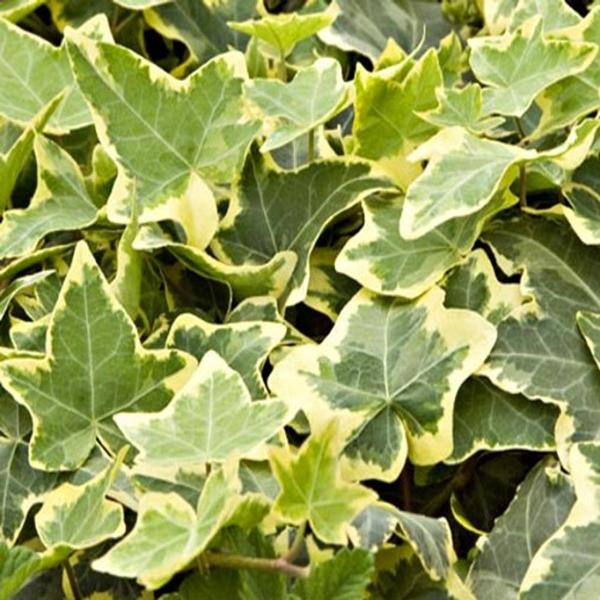
| PROS | CONS |
| The plant requires watering only when the soil is dry. Ivy is a nesting place for many birds and insects. | Ivy is extremely hard to remove and can cause great damage to things it grows. |
SPECIFICATIONS
- This perennial is shipped as a container.
- This perennial grows to a maximum height of 6 in. and a maximum width of 18 in.
- The best time for planting this perennial is during no-blossoms.
- The blooms of this perennial come in white.
- The botanical name of the perennial is Hedra Helix.
- This perennial has no scent.
- This plant has to have a minimum spacing of 12 inches between its plantings.
- This perennial can be returned within 180 days.
- This perennial is capable of tolerating part sun.
- This perennial attracts birds.
- This perennial deters deer and rabbits.
- The plant requires watering only when the soil is dry.
- The growth habit of this plant is spreading.
- The hardiness zone of this perennial is 11 (40 to 50 F),5 (-20 to -10 F).
KEY POINTS
- This plant is extremely capable of covering a patch of land with a dash of green quickly.
- Ivy is excessively used for the aesthetic enhancement it provides, and it can be grown even in your walls for a greeny look.
FAQ
Q1. Is Ivyscented?
No, Ivy has no fragrance.
Q2. Should this perennial be frequently watered?
No, Ivy requires watering only when the soil is dry.
5. Pot Blue Creeping Sedum Ground Cover with Blue/Green Foliage Edged in Pink Live Perennial Plant
This succulent is what you need to beautify your garden with hues. This easy-growing plant is hardy, making it gardener-friendly. The low-spreading nature of this perennial makes it an ideal choice for covering slopes which are present in sunny areas. The ¾ in. leaves of this plant are fleshy, round, and bluish-green with shades of pink in the corner. These leaves turn reddish in winters, and in late summers, star-shaped flowers blossom. For maintaining the compact growth habit of this plant, it is advisable to divide it every three years.
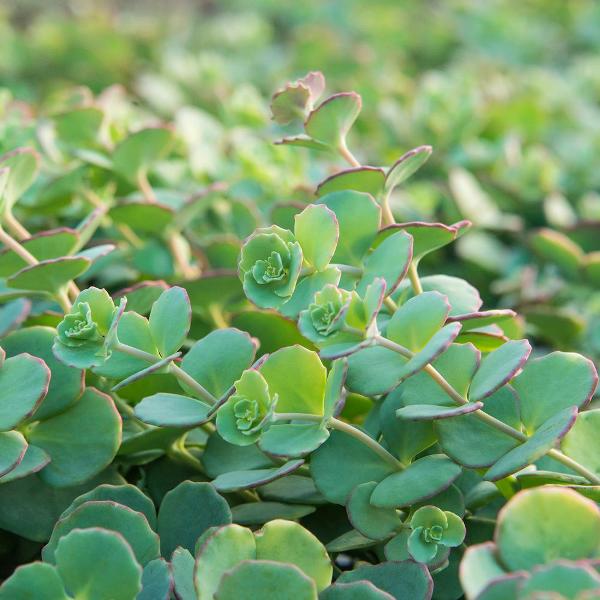
| PROS | CONS |
| Sedum requires watering twice a week only. Sedum is a grower-friendly choice because of its low maintenance. | The initial investment in Sedum is pricey sometimes. |
SPECIFICATIONS
- This perennial is shipped as a container.
- The plant is shipped at the height of 14 in.
- This perennial grows to a maximum height of 6 in. and a maximum width of 12 in.
- The best time for planting this perennial is from fall to spring.
- The blooms of this perennial come in blue color.
- The botanical name of the perennial is Sedum Sieboldii.
- This perennial has a scent.
- This plant has to have a minimum spacing of 14 inches between its plantings.
- This perennial can be returned within 180 days.
- This perennial is capable of tolerating full sun.
- This perennial attracts no wildlife.
- This perennial deters no wildlife.
- The plant requires watering twice a week.
- The growth habit of this plant is low-growing.
- The hardiness zone of this perennial is 3 (-40 to -30 F),4 (-30 to -20 F),5 (-20 to -10 F),6 (-10 to 0 F),7 (0 to 10 F),8 (10 to 20 F),9 (20 to 30 F).
KEY POINTS
- Sedum can last all through the year, and it leaves a great aesthetic impact on your garden.
- Sedum is extremely good tolerant of dry conditions and diseases.
FAQ
Q1. How much water is required?
Sedum requires watering twice every week.
Q2. To which width does the plant grow?
The plant grows to a width of 12 in.
6. Yellow/ White/ Pink/ Red Stonecrop Half Flat Sedum Groundcover
This plant is absolutely helpful if you need covering an area quickly with a dash of greens. These tough and resilient perennials have minimum water requirements and also show quick-paced growth. The color of this plant, the drought tolerance, and the easy maintenance that is required by this plant makes it a potentially preferred choice as a groundcover for the grower.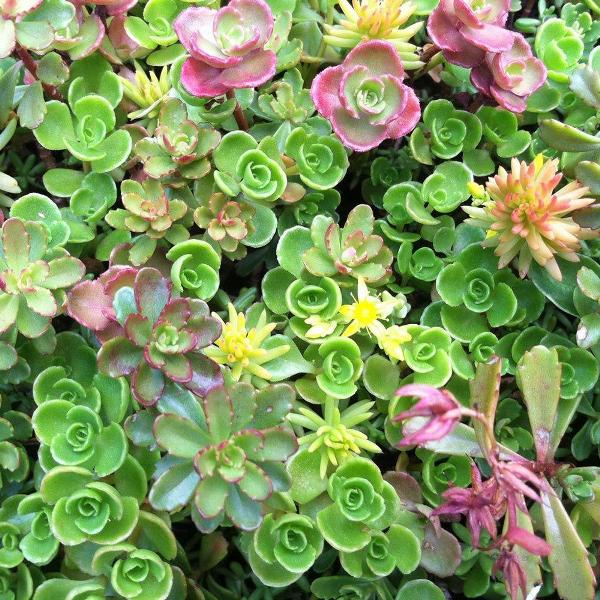
| PROS | CONS |
| This plant does not demand much of your time and attention. The plant does not require frequent watering. This perennial is thrivable, even in droughts. | This plant requires growing in the part sun only and is intolerable toward the full sun. |
SPECIFICATIONS
- This perennial is shipped as a container.
- This perennial grows to a maximum height of 6 in. and a maximum width of 10 in.
- The best time for planting this perennial is during no-blossoms.
- The blooms of this perennial come in assorted shades.
- The botanical name of the perennial is Stonecrop.
- This perennial has no scent.
- This plant has to have a minimum spacing of 12 inches between its plantings.
- This perennial can be returned within 180 days.
- This perennial is capable of tolerating part sun.
- This perennial attracts bees and butterflies.
- This perennial deters deer.
- The plant requires dry soil.
- The growth habit of this plant is spreading.
- The hardiness zone of this perennial is 4 (-30 to -20 F),7 (0 to 10 F).
KEY POINTS
- This plant is extremely capable of covering a patch of land with a dash of green quickly.
- This plant highly enhances the elegance of the garden with its assorted-shaded blooms.
FAQ
Q1. Is this plant scented?
This perennial has no fragrance.
Q2. Should this plant be frequently watered?
No, this plant requires watering twice a week only.
7. Variegated Lily Turf Plant
This plant, with its clumps of arching grass in a medium green with the yellow margined coloration, is great for uplifting the hues of your garden. The purple flowers resemble grape hyacinth, and they rise above the leaves during late summer, which is then replaced by darkly colored berries after the flower’s lifetime. This plant is grown in mass as a ground cover to accessorize your garden with greenery. The leaves are alive all through the winter. This plant is best suited for growing in the shade under a large tree. In colder regions, this perennial falls back to the ground every winter for conserving energy to regrow during spring.
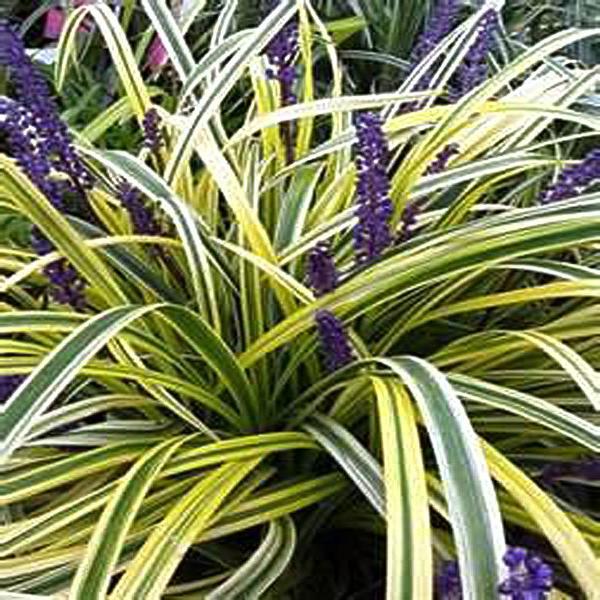
| PROS | CONS |
| This perennial is less risky to grow as it is not prone to any serious diseases or pests. Watering is required by this perennial only twice a week. The vibrant color of the flowers and foliage are a visual treat. | Lily Turf is intolerant towards holding traffic. |
SPECIFICATIONS
- The plant is shipped as a container.
- The plant is shipped at an average height of 8 in.
- The plant grows to an average height of 12 in. and an average width of 18 in.
- The best time for planting is around the year.
- The plant gives purple blossoms.
- The botanical name of the plant is Liriope muscari ‘Variegata.
- The common name of this plant is Lily.
- This plant does not give out any fragrance.
- This perennial has to have a minimum of 18 in. spacing between its plantings.
- This plant is returnable up to 180 days.
- This plant can tolerate full sun.
- This plant attracts no wildlife.
- No wildlife is deterred by this plant.
- The growth habit of this plant is clumping.
- The hardiness zone of this plant is 10 (30 to 40 F),5 (-20 to -10 F),6 (-10 to 0 F),7 (0 to 10 F),8 (10 to 20 F),9 (20 to 30 F).
- The plant requires medium watering.
KEY POINTS
- Lily Turf can thrive with any amount of light, be it full sun or deep shade except extremities like very hot summers and very cold winters.
- This perennial is exactly what you need if you are looking for covering a steep slope which is prone to soil erosion.
FAQ
Q1. How tall can this plant grow?
This plant can grow as to a maximum height of 12 inches and an average height of 8 – 10 in.
Q2. How to fertilize this perennial?
Sprinkling light doses of 10-10-10 fertilizer during spring would work fine. However, fertilizer is not needed by this plant, and using it excessively could induce pest problems.
8. Purple Creeping Myrtle Half Flat Myrtle Ground Cover
This plant can be used as a groundcover to gardens or shady areas where sunlight range is from part to full sun. These plants do not demand much of your time and attention. They are great for growing in bulbs, under trees, or on slopes and are suited for covering an area quickly.
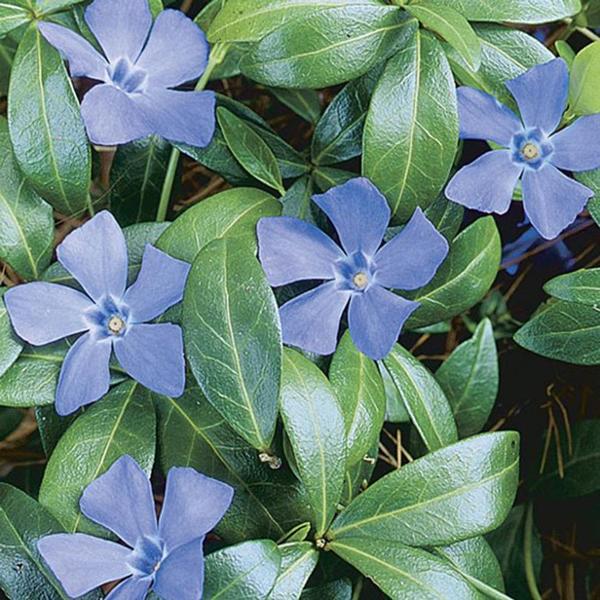
| PROS | CONS |
| This is one of those low maintenance plants that doesn’t demand too much of your efforts and attention. Watering is required only when the soil is completely out of moisture. | Newly planted creeping myrtles are susceptible to stem blights creating girdling lesions on them. |
SPECIFICATIONS
- The plant is shipped as a container.
- The plant is shipped at an average height of 3 in.
- The plant grows to an average height of 6 in. and an average width of 18 in.
- The best time for planting is in spring.
- The plant gives blooms in blue.
- The botanical name of the plant is Vinca Minor.
- This plant does not give out any fragrance.
- This perennial has to have a minimum of 8 in spacing between its plantings.
- This plant is returnable up to 180 days.
- This plant can tolerate part sun.
- This plant attracts pollinators like bees, butterflies, and hummingbirds.
- Deer and rabbits are deterred by this plant.
- The growth habit of this plant is spreading.
- The hardiness zone of this plant is 10 (30 to 40 F),4 (-30 to -20 F).
- The plant requires watering only when the soil is dry.
KEY POINTS
- This plant is greatly tolerant of drought.
- This plant is grown by gardeners in steep slopes for preventing and controlling soil erosion.
- This plant greatly enhances the aesthetic appeal when used as a ground cover in gardens and slopes.
FAQ
Q1. Is this plant tolerable to droughts?
Yes, this plant is drought-tolerant.
Q2. What kind of wildlife is attracted by this plant?
This plant attracts bees, butterflies, and hummingbirds.
9. Purple/Blue/Lavender/Pink Creeping Phlox Half Flat Phlox Groundcover
This plant is the splash of color that you would need to celebrate and welcome the onset of spring. This plant makes a great groundcover and is capable of remaining with a dose of semi-green even if it is not going through the flowering season. The plant gives pastel-colored blooms for 3-4 weeks during mid to late spring and is an ideal choice for using as bedding or for growing in walkways, pavers, or rocky areas.
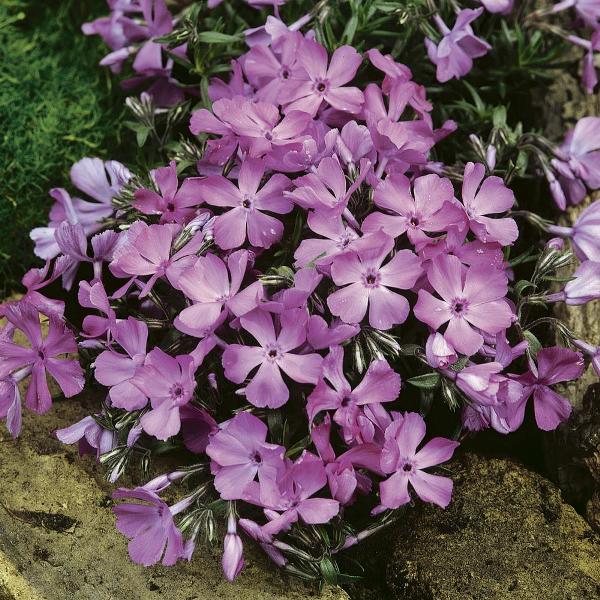
| PROS | CONS |
| This plant requires watering only when the soil is dry. Phlox is easily maintainable and tough. This plant is salt-tolerant. | This plant is not very attractive during the non-flowering periods. |
SPECIFICATIONS
- The plant is shipped as a container.
- The plant grows to an average height of 6 in. and an average width of 10 in.
- The best time for planting is in spring.
- The plant gives blooms in assorted colors.
- The botanical name of the plant is Phlox Subulata.
- This plant does not give out fragrance.
- This perennial has to have a minimum of 18 in. to 24 in. spacing between its plantings.
- This plant is returnable up to 180 days.
- This plant can tolerate part sun.
- This plant attracts butterflies.
- Deer and rabbits are deterred by this plant.
- The growth habit of this plant is creeping.
- The hardiness zone of this plant is 3 (-40 to -30 F),9 (20 to 30 F).
- The plant requires watering only when the soil is dry.
KEY POINTS
- This plant is capable of giving a mat of blooms for four weeks during spring.
- The roots are capable of spreading themselves avoiding the need for human intervention.
- This plant is stubborn once established and is capable of hiding uneven grounds.
FAQ
Q1. What kind of wildlife is attracted by this plant?
This plant attracts butterflies.
Q2. Should this plant be watered daily?
Not necessary. This plant requires watering only when the soil is dry.
10. Ever Amethyst Agapanthus with Reblooming Purple Flower Clusters
This plant is a famous perennial which produces vibrant purple bloom clusters during spring, which is capable of reflowering into summer. This plant is capable of expanding into clumps of many plants, with each individual plant possessing the capability of flower production and expansion. Planting them in places of rich soil with good drainages like hedges, container plantings, and garden beds can brighten up space. Fertilizing during early spring using a slow-release fertilizer is recommended.
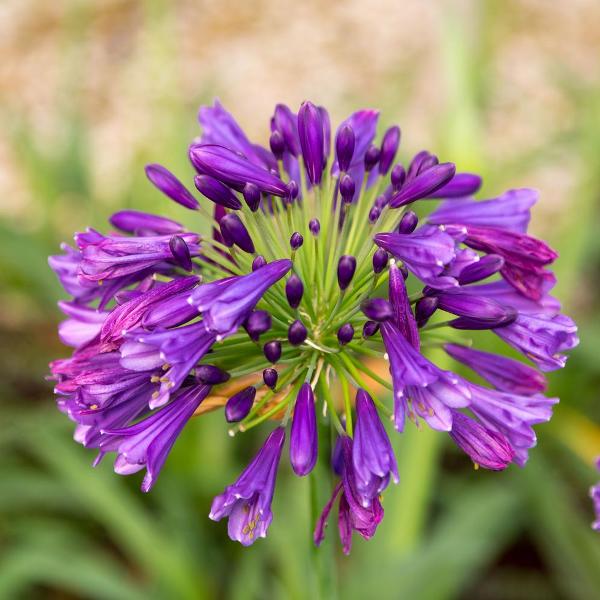
| PROS | CONS |
| This plant requires watering twice a week only. This plant is extremely tireless and easy to maintain once it is established. | If the soil is not sufficiently draining, the plant root system may rot and crown. |
SPECIFICATIONS
- The plant is shipped as a container.
- The plant is shipped at an average height of 7 in.
- The plant grows to an average height of 36 in. and an average width of 24 in.
- The best time for planting is from spring to fall.
- The plant gives blooms in purple color.
- The botanical name of the plant is Agapanthus hybrid ‘MP003’ PP30163.
- The common name of this plant is Lily of the Nile.
- This plant gives out no fragrance.
- This perennial has to have a minimum of 18 in. spacing between its plantings.
- This plant is returnable up to 180 days.
- This plant can tolerate full sun.
- This plant attracts pollinators like butterflies.
- No wildlife is deterred by this plant.
- The growth habit of this plant is clumping.
- The hardiness zone of this plant is 10 (30 to 40 F),11 (40 to 50 F),8 (10 to 20 F),9 (20 to 30 F).
- The plant requires watering twice a week.
KEY POINTS
- This plant is a disease and pest resistant.
- This plant is also capable of drought tolerance.
- The quick-growing nature of this plant makes it a more preferable grower’s choice.
FAQ
Q1. What wildlife does this plant attract?
This plant attracts pollinators like butterflies.
Q2. How often should this plant be watered?
This plant requires watering twice a week.
11. Ever White Agapanthus with Reblooming Brilliant White Flower Clusters
This perennial gives out white bloom clusters that blossom during spring and reflower into summer. Each individual plant of a cluster is capable of flowering, giving rise to numerous plants, making it an ideal choice for planting in garden beds, foundation plantings and containers. This plant thrives on soil, which is enriched with nutrients and possesses good drainage. The plants grow best in full shade to part shade and are an ideal choice for growing on borders.
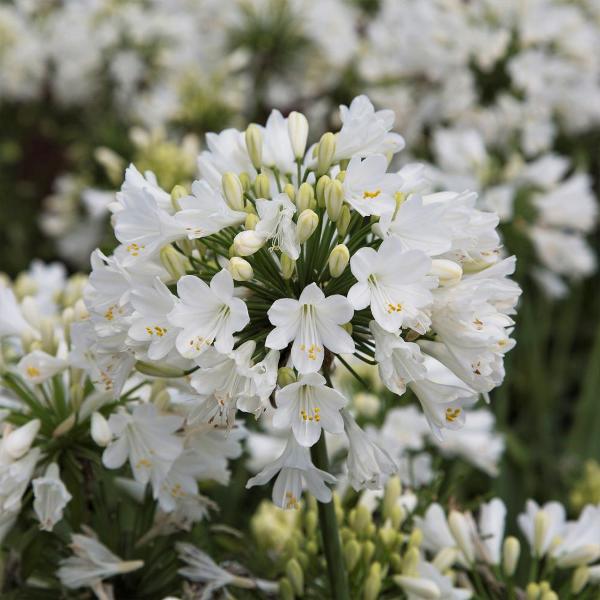
| PROS | CONS |
| These plants grow in moist soils and are capable of tolerating saltwater. Agapanthus is an easily maintainable plant that can tolerate droughts and resists diseases and insects. | Allergic people are advised to handle this plant with care, as this plant may trigger skin irritation. |
SPECIFICATIONS
- The plant is shipped as a container.
- The plant is shipped at an average height of 6 in.
- The plant grows to an average height of 24 in. and an average width of 24 in.
- The best time for planting is spring to fall.
- The plant gives white blooms.
- The botanical name of the plant is Agapanthus hybrid ‘WP001 PP27357.
- The common name of this plant is Lily of the Nile.
- This plant is non-fragrant.
- This perennial has to have a minimum of 18 in. spacing between its plantings.
- This plant is returnable up to 180 days.
- This plant can tolerate full sun.
- This plant attracts butterflies
- No wildlife is deterred by this plant.
- The growth habit of this plant is clumping.
- The hardiness zone of this plant is 10 (30 to 40 F),11 (40 to 50 F),8 (10 to 20 F),9 (20 to 30 F).
- The plant requires watering twice a week.
KEY POINTS
- This plant greatly resists diseases and insects.
- This plant is all you need if you are looking to fill gaps or uneven landscapes with brightly colored blooms.
- This plant is also capable of thriving long durations of drought.
FAQ
Q1. How often should this plant be watered?
This plant requires watering twice a week only.
Q2. Does this plant attract any wildlife?
This plant attracts butterflies.
12. Ever Twilight Agapanthus with Reblooming White and Violet Blue Flower Clusters
This perennial produces blossom clusters, which are of a mixed coloration of white and violetish blue. These blossoms emerge during spring and reflower into fall. This plant tends prolific blooming as each individual plant can produce flower clumps giving rise to a large amount of flowers. Watering for at least thrice a week and fertilizing every year with a light application of slow fertilizer encourages the best results. This plant is ideal for growing in front of hedges, foundation plantings, and containers.
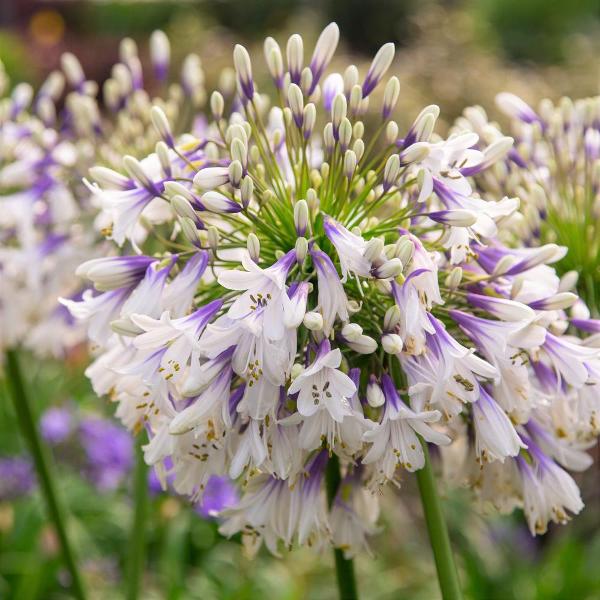
| PROS | CONS |
| This plant shows a great deal of tolerance towards droughts. Once established, this plant is very easy to maintain. | This plant requires soil, which has a good amount of drainage as low drainage in the soil can lead to the rotting of the plant roots. |
SPECIFICATIONS
- The plant is shipped as a container.
- The plant is shipped at an average height of 6 in.
- The plant grows to an average height of 24 in. and an average width of 24 in.
- The best time for planting is from spring to fall.
- The plant gives bicolored blooms.
- The botanical name of the plant is Agapanthus Hybrida ‘MDB001’ PP30162.
- The common name of this plant is Lily of the Nile.
- This plant is non-fragrant.
- This perennial has to have a minimum of 18 in. spacing between its plantings.
- This plant is returnable up to 180 days.
- This plant can tolerate full sun.
- This plant attracts wildlife like butterflies.
- No wildlife is deterred by this plant.
- The growth habit of this plant is clumping.
- The hardiness zone of this plant is 10 (30 to 40 F),11 (40 to 50 F),9 (20 to 30 F), 8(10 to 20 F).
- The plant requires watering twice a week.
KEY POINTS
- This plant is an ideal choice to grow as a ground cover as it amazingly uplifts your garden’s looks with a subtle splash of color.
- Agapanthus is greatly resistant towards diseases and insects, making it more easily maintainable.
FAQ
Q1. How often should this plant be watered?
This plant requires watering only once a week.
Q2. Does this plant attract any wildlife?
This plant attracts no wildlife.
13. Evergreen Stella Golden-Yellow Live Perennial Daylily Plant, Fragrant and Trumpet-Shaped Flowers
This perennial gives trumpet-shaped and golden yellow-shaded blossoms that can make a stunning addition to your container gardeners and landscapes. The blooms have a good amount of fragrance. This perennial is widely adaptive to many soil types and can show the best growth results in partial to full sun.

| PROS | CONS |
| This plant is drought tolerant. This plant is a low-maintenance plant that is not susceptible to diseases. This plant requires watering once a week only. | Daylilies have a tendency of self-propagating, and hence eradicating them completely can be tiring. |
SPECIFICATIONS
- The plant is shipped as a container.
- The plant is shipped at an average height of 6 in.
- The plant grows to an average height of 36 in. and an average width of 24 in.
- The best time for planting is from spring to fall.
- The plant gives yellow blooms.
- The botanical name of the plant is Hemerocallis Evergreen Stella.
- The common name of this plant is Daylily.
- This plant is fragrant.
- This perennial has to have a minimum of 9 in. spacing between its plantings.
- This plant is returnable up to 180 days.
- This plant can tolerate full sun.
- This plant attracts bees and hummingbirds.
- No wildlife is deterred by this plant.
- The growth habit of this plant is clumping.
- The hardiness zone of this plant is 4 (-30 to -20 F),5 (-20 to -10 F),6 (-10 to 0 F),7 (0 to 10 F),8 (10 to 20 F),9 (20 to 30 F).
- The plant requires watering once a week.
KEY POINTS
- Daylilies have a great deal of aesthetic and ornamental value that can bless your garden with stunning looks.
- This plant is greatly hardy, making it adaptable for a wide range of temperatures.
FAQ
Q1. How much water is required by this plant?
This plant needs to be watered once a week only.
Q2. What is the height to which this plant grows?
The plant grows to a maximum height of 12 inches.
14. Ever Midnight Agapanthus with Reblooming Dark Blue Flower Clusters
This perennial produces blossom clusters, which are violetish blue. These blossoms emerge during spring and reflower during fall. The prolific blooming is one of the most desired attributes in this perennial. Also, this perennial is capable of expanding into clusters of numerous plants hence resulting in huge amounts of blossoms. Rich garden soil, which is capable of good drainage and fertilization by lightly applying a balanced slow-release, is paramount. This plant lightens your mood with its colorful blossoms, which grow best in full shade to part shade.
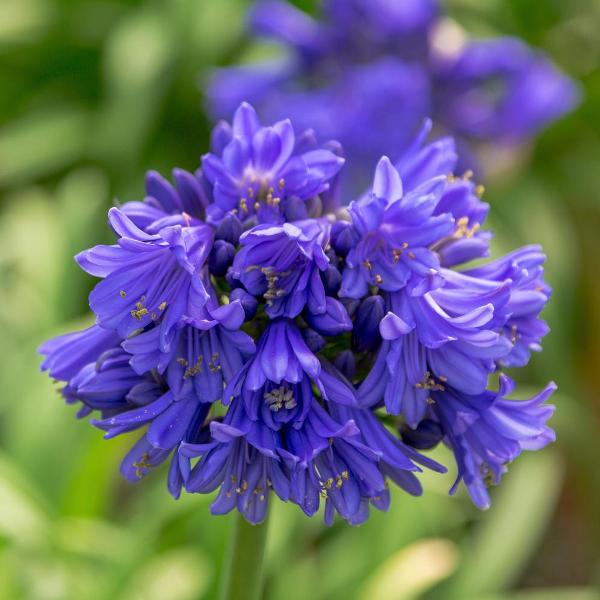
| PROS | CONS |
| The plant requires watering twice a week only. This perennial does not demand for much of your energy or attention once established. | This plant has a root system that is capable of rotting and collapsing if the plant is not grown in soil with sufficient drainage. |
SPECIFICATIONS
- The plant is shipped as a container.
- The plant is shipped at an average height of 6 in.
- The plant grows to an average height of 36 in. and an average width of 36 in.
- The best time for planting is from spring to fall.
- The plant gives white-colored blooms.
- The botanical name of the plant is Agapanthus Hybrida ‘MDB001’ PP30162.
- The common name of this plant is Lily of the Nile.
- This plant is non-fragrant.
- This perennial has to have a minimum of 9 in. spacing between its plantings.
- This plant is returnable up to 180 days.
- This plant can tolerate full sun.
- This plant attracts bees and hummingbirds.
- No wildlife is deterred by this plant.
- The growth habit of this plant is clumping.
- The hardiness zone of this plant is 10 (30 to 40 F),11 (40 to 50 F),8 (10 to 20 F),9 (20 to 30 F)
- The plant requires watering twice a week.
KEY POINTS
- This plant is all you need if you are looking for a bedding or ground cover that can enhance the look and feel of your garden.
- This plant is disease resistant and insect resistant, making it more popular amongst growers.
FAQ
Q1. How much water is needed by the plant?
The plant needs watering twice a week.
Q2. What is the spacing needed to be maintained while growing this plant?
The plants should be planted 18 in. apart.
15. Ever Sapphire Agapanthus with Reblooming Violet Blue Flower Clusters
This perennial produces high quality, bright-violet bloom clusters which bud in spring and reflower during summer. The early blossoming and reflowering capability of this plant make it a preferable choice for growers. Each plant gives rise to numerous other plants that are capable of flowering. This perennial requires soil, which is enriched with nutrients and are capable of good drainage. Watering three to four times a week is recommended during the growing season. A large number of flowers that they produce make them greatly useful for planting in front of hedges, foundation plantings, beds, or containers to add splashes of colors.
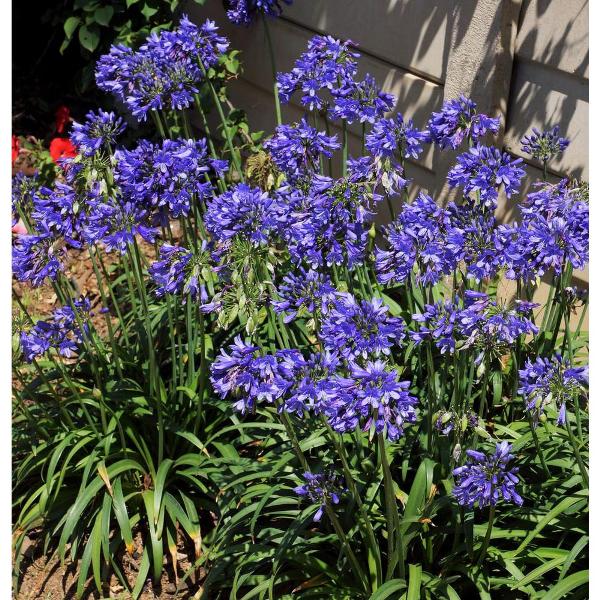
| PROS | CONS |
| This plant does not need watering more than twice a week. This plant is non-fragrant, which makes it a suitable choice for those who find it hard to tolerate fragrances. | The plant has to be keenly taken care of as the roots may rot if the soil doesn’t hold a good amount of drainage. |
SPECIFICATIONS
- The plant is shipped at a height of 6 inches.
- The plant grows to an average height of 24 in. and an average width of 24 in.
- The best time for planting is spring to fall.
- The color of the blooms is blue.
- The botanical name of the plant is Agapanthus hybrid ANDbin PP26336.
- The common name of this plant is Lily of the Nile.
- It does not give out any fragrance.
- This perennial has to have a minimum of 18 inches between its plantings.
- This plant is returnable up to 180 days.
- This plant can tolerate full sun.
- This plant attracts pollinators like butterflies.
- No wildlife is deterred by this plant.
- This plant is shipped as a container.
- This plant requires watering twice a week.
- The growth habit of this plant is clumping.
- The hardiness zone of this plant is 10 (30 to 40 F),11 (40 to 50 F),8 (10 to 20 F),9 (20 to 30 F).
KEY POINTS
- This plant uplifts your garden aesthetics if grown as garden covers and soil covers or under trees.
- This plant is disease-resistant and insect resistant.
FAQ
Q1. At which height is the plant shipped?
The plant is shipped at the height of 6 in.
Q2. Does this plant require frequent watering?
No, this plant doesn’t require frequent watering. It has to be watered twice a week only.
These are some of the best perennial plants for growing as a ground cover, which will never fail to bless your garden with immense looks and vibrant colors.





